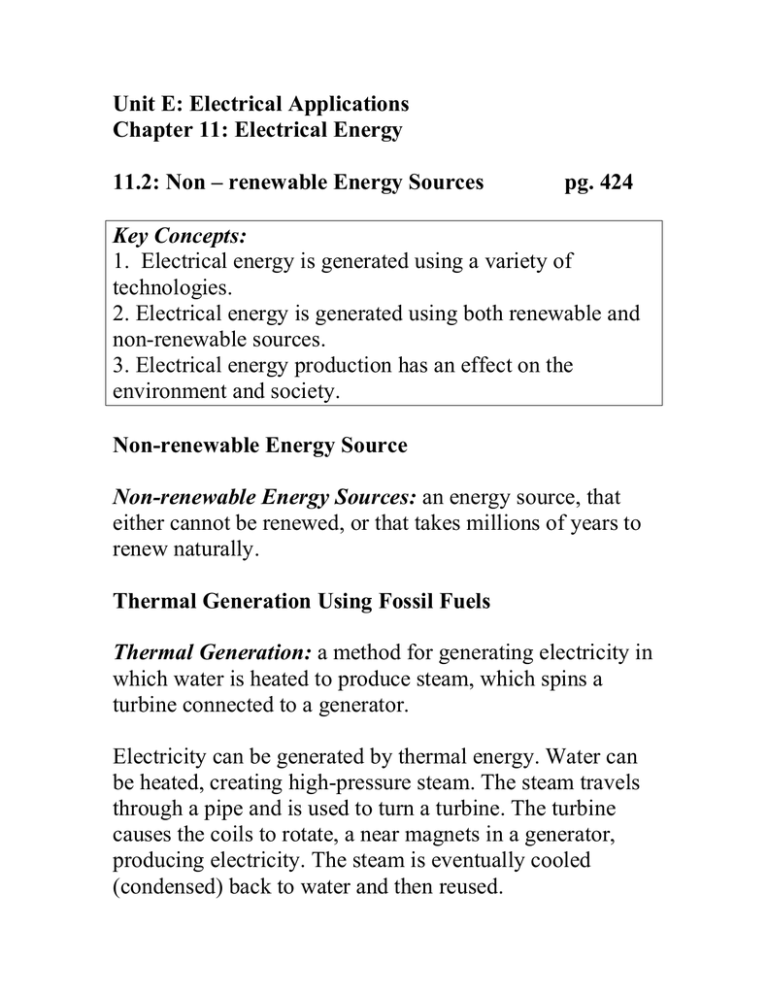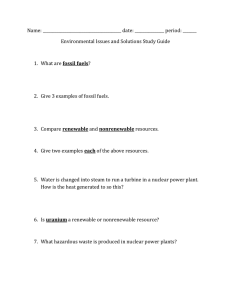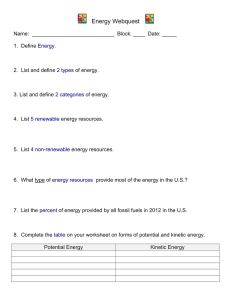Unit E: Electrical Applications Chapter 11: Electrical Energy
advertisement

Unit E: Electrical Applications Chapter 11: Electrical Energy 11.2: Non – renewable Energy Sources pg. 424 Key Concepts: 1. Electrical energy is generated using a variety of technologies. 2. Electrical energy is generated using both renewable and non-renewable sources. 3. Electrical energy production has an effect on the environment and society. Non-renewable Energy Source Non-renewable Energy Sources: an energy source, that either cannot be renewed, or that takes millions of years to renew naturally. Thermal Generation Using Fossil Fuels Thermal Generation: a method for generating electricity in which water is heated to produce steam, which spins a turbine connected to a generator. Electricity can be generated by thermal energy. Water can be heated, creating high-pressure steam. The steam travels through a pipe and is used to turn a turbine. The turbine causes the coils to rotate, a near magnets in a generator, producing electricity. The steam is eventually cooled (condensed) back to water and then reused. The most common way to produce steam from water is by burning fossil fuels, such as; coal, oil and natural gas. Fossil fuels are classified as non-renewable, although they are formed naturally by the decaying of organic matter, microbes, plants and animals; it takes millions of years to form. Table 1: Advantages and Disadvantages of Using Fossil Fuels - Much less expensive than other sources Advantages - non-renewable Disadvantages - Releases carbon dioxide and other greenhouse gasses into the air, contributing to climate change. - Obtaining fossil fuels disturbs or destroys habitats - Refining and burning fossil fuels cause pollution, including acid precipitation. - Uses large volumes of water to cool and condense steam, which can cause thermal pollution. Thermal Generation Using Nuclear Energy Nuclear power plants use Uranium as a fuel. In the nucleus of an atom of uranium is where the atom stores large amounts of energy, called nuclear energy. As these atoms break apart, the atoms nuclear energy is transformed into thermal energy. This reaction is called nuclear fission. One small pellet of uranium produces as much energy as 570 L of oil. These pellets are put into metal rods, known as fuel rods. The rods are put into a nuclear reactor where the energy released will heat water into steam which is then used to turn turbines and generate electricity. The fuels rods, when depleted of their energy, now become nuclear waste. These rods are radioactive and are hazardous to the environment. The rods are stored on site for 10 years, in a storage canisters; in cold water pools. These canisters are then sealed in concrete, 1 metre thick. After 60 years these cement, these canisters are shipped to long term storage facilities. The waste produces take tens of thousands of years to decompose to a safe material. Table 2: Advantages and Disadvantages of Using Nuclear Fission - Does not cause air pollution directly Advantages - Does not emit greenhouse gases directly. Disadvantages - Non-renewable energy source Produces dangerous radioactive wastes Mining uranium results in air, water, and land pollution. Plants are expensive to build and maintained. Uses large volumes of water to cool and condense steam, which can cause thermal pollution. Some risk of serious accidents due to human error, equipment failure, or earthquake. Check Your Learning: Questions 1 – 5, pg. 427 Wrap Up: - Sources used to generate electrical energy can be nonrenewable. - Non-renewable sources include fossil fuels and uranium. - Producing energy from non-renewable fuels has advantages and disadvantages for society and the environment. 11.2: Non – renewable Energy Sources pg. 424 Table 1: Advantages and Disadvantages of Using Fossil Fuels - Much less expensive than other sources Advantages - non-renewable Disadvantages - Releases carbon dioxide and other greenhouse gasses into the air, contributing to climate change. - Obtaining fossil fuels disturbs or destroys habitats - Refining and burning fossil fuels cause pollution, including acid precipitation. - Uses large volumes of water to cool and condense steam, which can cause thermal pollution. Table 2: Advantages and Disadvantages of Using Nuclear Fission - Does not cause air pollution directly Advantages - Does not emit greenhouse gases directly. Disadvantages - Non-renewable energy source Produces dangerous radioactive wastes Mining uranium results in air, water, and land pollution. Plants are expensive to build and maintained. Uses large volumes of water to cool and condense steam, which can cause thermal pollution. Some risk of serious accidents due to human error, equipment failure, or earthquake.






